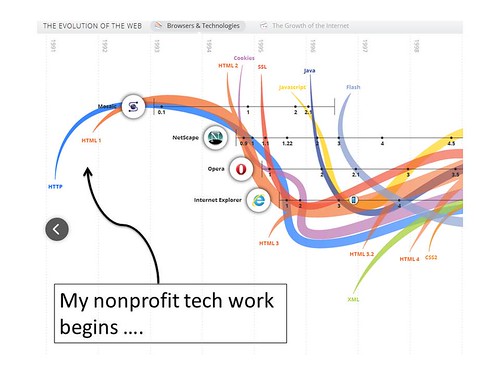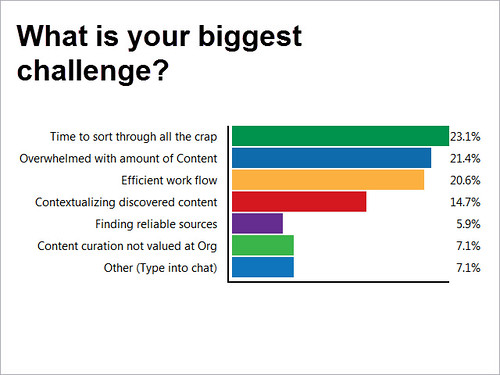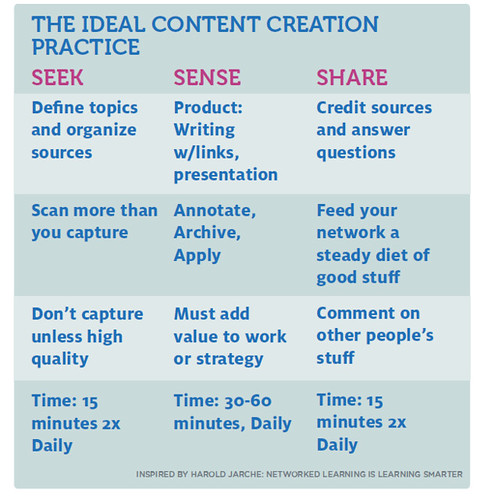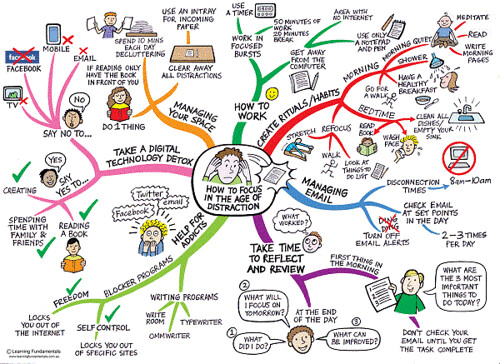Yesterday, I did a free NTEN Webinar called “The Unanticipated Benefits of Content Curation: Reducing Information Overload” based on my feature article in the NTEN Change Journal in June with the same title. (You can register and download the issue here for free and listen to the webinar recording here) The main idea is that good curation skills can build staff expertise and avoid the pain of information overload. I covered the basics of content curation, how it differs from social sharing, the art and practice of curation, a frameworks to get started, examples of nonprofits using curation, the tools, and some techniques for minimizing information overload and managing attention. I pulled together a curated summary of the tweets and resources on Storify that you can view here.
With over 600 people registered for the Webinar, it was hard to answer all the questions as the chat stream just flew by and the 90 minutes was up before we knew it. I promised folks that I would share a summary blog post with links, questions, and resources.
With so many people, it was a challenge to make this Webinar interactive, but there was a lot of discussion in the chat and some online activities. One important skill of the curator is to provide context, so I started with sharing my lens on this topic.

I was lucky to have a front row seat at the beginning of the nonprofit tech field back in 1992 – when nonprofits were first exploring how the Internet could be used for activist and mission-driven work. I confess to being an early adopter – someone who overpaid for technology tools that didn’t work and still do that today.

My first job in this area was with an online network called Arts Wire where I learned new technologies as they came out – like email, HTML, and created and lead trainings, provided online support.
I was reflecting back to those days and I realized that part of my work included content curation, although at the time I didn’t call it that. I also taught many workshops where I included techniques on how to deal with information overload caused by using the Internet to get our work done. Back in the 1990s, the overload was coming from email. Fast forward to today, I link both these ideas, but have now realized that content curation – the good practice of it – can help reduce that feeling.


A good curator also knows their audience. So I asked a few questions to determine the level of experience and current challenges and used the Webinar platform polling features. I had a mixed group of participants new to the practice and those who were doing it informally. The challenges all seemed to indicate a need for better attention and filtering skills. I also asked for burning questions in the chat and all were terrific and addressed in the webinar. Most were answered in the presentation as well as the article and few great questions were asked and I will certainly address in future blog posts.

They key point I wanted to make was that content curation is not social sharing.
Curation has nothing to do with personal expression or sharing nor with collecting links, tweets or blog posts that you may find interesting. Curation is all about helping your audience dive in and make sense of a specific topic, issue, event or news story. It is about collecting, but it is also about explaining, illustrating, bringing in different points of view and updating the view as it changes. It is also about sharing with your community – not passing along stuff that you have not read or contextualize or shooting out links. But engaging in dialogue to help them make sense.
I shared master curator Robin Good’s detailed checklist of skills. I suggested that people follow his content curation activity, and you will learn much about the practice. The skills:
• Optimizes
• Edits
• Formats
• Selects
• Excerpts
• Writes
• Classifies
• Links
• Personalizes
• Vets
• Credits
• Filters
• Taps
• Suggests
• Searches
• Scouts
• Hacks Filters and Searches
• Is Transparent
• Recommends
• Crowdsources
The list of skills might, at first blush, feel like a lot of extra work. It isn’t once you’ve established good habits. And, the benefits of good curation far outweigh pumping and pumping huge quantities of uncontextualized links.

I believe that in learning a new skill or habit you have to start with small baby steps. I shared the “Seek, Sense, Share” remarked that was inspired by Harold Jarche who popped into the twitter stream that he was just in Rome and had a great conversation with Robin Good about content curation! Harold blogged about that here.
There were a lot of questions about the tools.
Master curator, Robin Good, is go to curator on curation tools. Robin recently shared his comprehensive map of content curation skills, dividing them into couple of key categories. There are over 250 tools in this collection, so it might be a little bit overwhelming for beginners. Last January, I had the opportunity to present with Robin at the Social Media 4 Nonprofits Conference and he was very generous with his time, agreeing to do a video interview on skype before the session. I asked what if someone was new to content curation – and wanted to consider a short list of tools. One of the points he made during our planning call is that in order to curate, you need two sets of tools – news discovery and curation tools. News discovery tools select and aggregate content based on keyword searches, but give a higher signal to noise ratio than general keywords searches or general news sites. Curation tools are platforms that let you display your collection.

Managing Attention As Your Curate
The last segment focused on an assessment and tips for how participants manage their attention while curating and some techniques to avoid getting “content fried.” We have to cover a lot of ground in our work today and do it while logged on to the greatest tool for distraction and procrastination ever invented! Self-awareness is the first step. I gave a cosmos quiz of ten questions to answer yes/no.
1.When you open email or do social media or curation tasks, does it make you feel anxious?
2.When you are seeking information to curate, have you ever forgotten what it was in the first place you wanted to accomplish?
3.Do you ever wish electronic information would just go away?
4.Do you experience frustration at the amount of electronic information you need to process daily?
5.Do you sit at your computer for longer than 30 minutes at a time without getting up to take a break?
6.Do you constantly check (even in the bathroom on your mobile phone) your email, Twitter or other online service?
7.Is the only time you’re off line is when you are sleeping?
8.Do you feel that you often cannot concentrate?
9.Do you get anxious if you are offline for more than a few hours?
10.Do you find yourself easily distracted by online resources that allow you to avoid other, pending work?
Those who scored 0-3 are doing great with their attention, but only 10% of participants did. Scoring between 4-6 is where most participants were at with 60% scoring there. And 30% scored over 7 which means they need to train their attention right away! About a year ago, I scored a 10 and realized that I needed to work on changing my habits, one technique at a time. About the the same time, I discovered that mindmap and used in a post to share my plan. One of the things that helped me was to go slowly and return to drawing and visual thinking techniques. Incorporating some mini-reflections into my day also helped.
I concluded the workshop by asking folks to pick out one idea that will put into practice from the curation webinar and promised to write this post and include the resources mentioned.
Content Curation Primer – my introduction for those who are new to the technique
What Can Nonprofits Learn from Robin Good, Best Content Curator on the Planet? – If you want to get better at the art and craft of content curation, read through this post and interview with Robin Good. Spend time looking through his how-tos and tools sections.
Content Curation for Nonprofits Resources – This is my curated collection of links and resources that I use to support workshops I’m teaching on content curation.
Content Curation for Nonprofits, Scoop-It – This is my scoop.it collection where I curate resources about content curation that are relevant for nonprofits.
Review of Howard Rheingold’s NetSmart – If you want to go deeper with learning how to train your attention and other online skills needed to succeed in this age of connectedness.
NTEN Webinar Reflections and Resources: The Unanticipated Benefits of Content Curation
The Unanticipated Benefits of Content Curation
View more presentations from Beth Kanter
